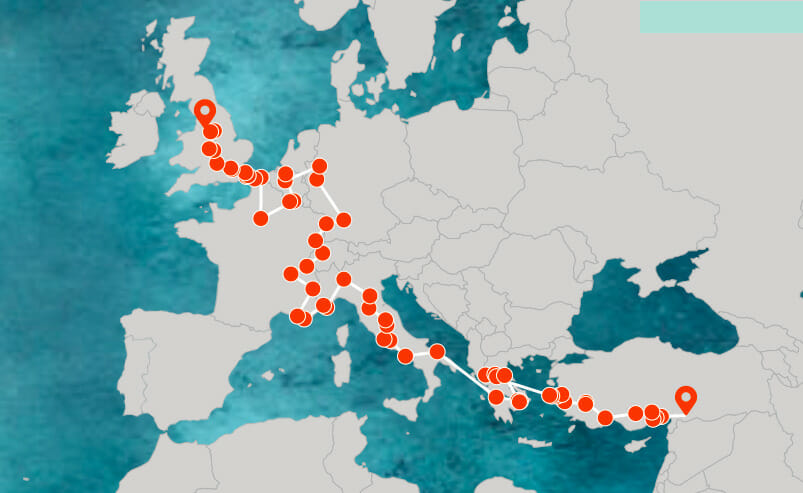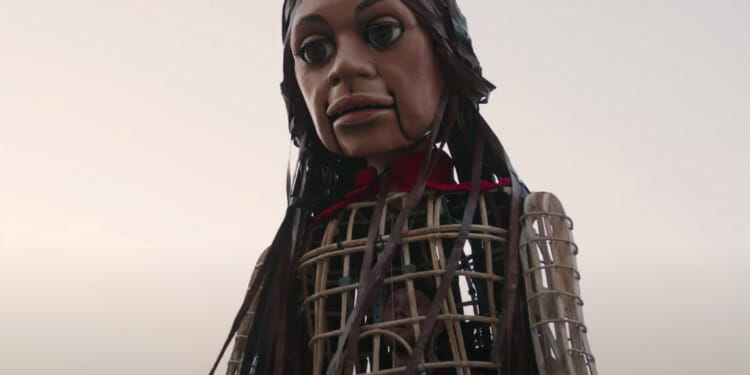This morning, Little Amal – a 3.5-metre-tall puppet of a young refugee girl – met with children in Deptford, UK, on her way to London.
Little Amal is the protagonist of an art initiative, “The Walk”, hoping to bring global attention to the plight of millions of young refugees, representing all displaced children who have been separated from their families.
Since July she has taken an 8,000km journey through Turkey, Greece, Italy, Switzerland, Germany, Belgium, France, and has recently reached the UK, ending her trip on November 3rd in Manchester. Her journey is meant to represent the route that a child from Syria might take.
The character of Amal was developed from a play created by the refugee theatre company Good Chance. It was launched in the Calais encampment (of notorious fame) at the height of the migration crisis in 2016. The production of The Walk was led by Artistic Director, Amir Nizar Zuabi, and the puppet itself was designed by the Handspring Puppet Company, known for its award-winning design of the puppets of the long-running West End play, War Horse. Amongst the puppeteers for the production are former refugees from Calais, manipulating her arms in greeting as she walks through European cities.
It is important to note that her journey is not a walk of misery but a walk of pride. Although the route has been undertaken by several refugees, producers have not attempted to portray the bleaker end of the child migrant experience, such as the trips beneath the undercarriages of lorries, dangerous boat crossings, or hostility from border guards.

Amir Nizar Zuabi, wanted to challenge the perception that refugees were an issue or a problem, and instead demonstrate the potential they bring along with them during their journey towards refuge in Europe.
“It is because the attention of the world is elsewhere right now that it is more important than ever to reignite the conversation about the refugee crisis and to change the narrative around it. Yes, refugees need food and blankets, but they also need dignity and a voice. The purpose of The Walk is to highlight the potential of the refugee, not just their dire circumstances. Little Amal is 3.5 metres tall because we want the world to grow big enough to greet her. We want her to inspire us to think big and to act bigger.”
– Amir Nizar Zuabi
The Walk is a celebration of migration and cultural diversity intended to tell the story of the contributions made by refugees and immigrants. It represents the refugee story as one of potential, success, respect, hospitality, and kindness.
THE PUBLIC OPINION: A MIRROR OF REALITY?
As many citizens throughout Europe welcomed her, she was not always greeted with open arms. In Greece, for example, far-right protesters threw things at her as she walked through the streets, local councillors voted to ban her from visiting a village of Orthodox monasteries, and protests in Athens meant her route had to be diverted.
related articles: Art as a Driver for Change: The Plastic Museum in Indonesia | Europe’s Refugee Crisis Is a Crisis of Humanity, not Migration.
In France, as she recently made her way to Bray-Dunes beach near Calais, the mayor raised clear objections to her presence. Especially as British politicians are currently debating the nationality and borders bill which plans to punish people who arrive in the United Kingdom through unauthorised routes with a jail sentence of up to 4 years. In short, it was a direct response to the growing refugee crisis at Calais.
These occurrences were, however, relatively few compared to the widespread support and various signs of encouragement to the rest of Amal’s journey.
Little Amal made a new friend in Rome… #LittleAmal #Rome #VaticanCity pic.twitter.com/vZ3CCWxREJ
— Little Amal (The Walk) (@walkwithamal) September 18, 2021
But, whilst her journey was most definitely not as challenging, strenuous, painful mentally and physically, or dangerous as it is for refugees undertaking the same route, Little Amal’s presence mirrored a certain reality.
There is little surprise that the few moments of overt hostility came from Greece or Calais, locations that have found themselves at the epicentre of the migration crisis since 2015. The rapid rate of European immigration has fuelled the rise of far-right political movements within these areas, driving greater hostility and bitterness against the plights for refugees. The Greek and French governments have been openly criticised for their inhumane and degrading treatments of refugees within their camps, with authorities carrying out abusive practices to deter new arrivals.
Amal offers an opportunity for people to take a moment and reflect on their attitudes towards refugees, particularly towards the hundreds of thousands of displaced children forced to flee their homes because of conflict over the past decade. The hope is that Amal can make a difference. Only time will tell, but Amal undoubtedly illustrates the power of art to effect change, if not right away, over time.
Editor’s Note: The opinions expressed here by Impakter.com columnists are their own, not those of Impakter.com. — In the Featured Photo: Little Amal in Tantrum, Italy, greeting young children. Featured Photo Credit: Good Chance Theatre.










